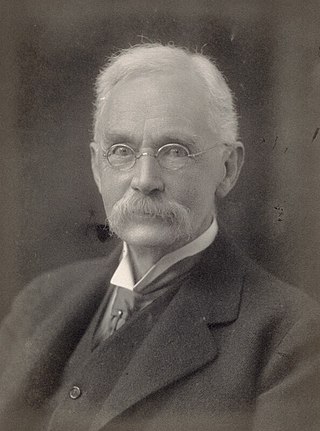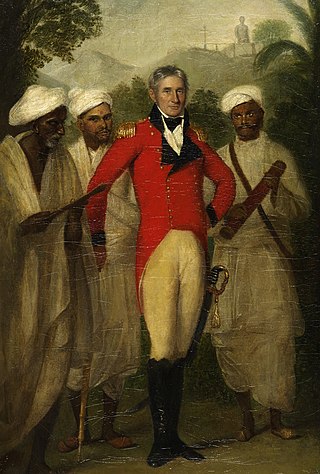Related Research Articles

Colonel William Henry Sykes, FRS was an English naturalist who served with the British military in India and was specifically known for his work with the Indian Army as a politician, Indologist and ornithologist. One of the pioneers of the Victorian statistical movement, a founder of the Royal Statistical Society, he conducted surveys and examined the efficiency of army operation. Returning from service in India, he became a director of the East India Company and a member of parliament representing Aberdeen.

Thomas William Rhys Davids was an English scholar of the Pāli language and founder of the Pāli Text Society. He took an active part in founding the British Academy and London School for Oriental Studies.

The Royal Asiatic Society of Great Britain and Ireland, commonly known as the Royal Asiatic Society, was established, according to its royal charter of 11 August 1824, to further "the investigation of subjects connected with and for the encouragement of science, literature and the arts in relation to Asia." From its incorporation the society has been a forum, through lectures, its journal, and other publications, for scholarship relating to Asian culture and society of the highest level. It is the United Kingdom's senior learned society in the field of Asian studies. Fellows of the society are elected regularly and include highly accomplished and notable scholars of Asian studies; they use the post-nominal letters FRAS.

Colonel Colin Mackenzie was Scottish army officer in the British East India Company who later became the first Surveyor General of India. He was a collector of antiquities and an orientalist. He surveyed southern India, making use of local interpreters and scholars to study religion, oral histories, inscriptions and other evidence, initially out of personal interest, and later as a surveyor. He was ordered to survey the Mysore region shortly after the British victory over Tipu Sultan in 1799 and produced the first maps of the region along with illustrations of the landscape and notes on archaeological landmarks. His collections consisting of thousands of manuscripts, inscriptions, translations, coins and paintings, which were acquired after his death by the India Office Library and are an important source for the study of Indian history. He was awarded a Companion of the Order of the Bath on 4 June 1815.

James Prinsep FRS was an English scholar, orientalist and antiquary. He was the founding editor of the Journal of the Asiatic Society of Bengal and is best remembered for deciphering the Kharosthi and Brahmi scripts of ancient India. He studied, documented and illustrated many aspects of numismatics, metallurgy, meteorology apart from pursuing his career in India as an assay master at the mint in Benares.

Major General Sir Alexander Cunningham was a British Army engineer with the Bengal Engineer Group who later took an interest in the history and archaeology of India. In 1861, he was appointed to the newly created position of archaeological surveyor to the government of India; and he founded and organised what later became the Archaeological Survey of India.

The Archaeological Survey of India (ASI) is an Indian government agency that is responsible for archaeological research and the conservation and preservation of cultural historical monuments in the country. It was founded in 1861 by Alexander Cunningham who also became its first Director-General.
Charles Lionel Augustus de Nicéville was a curator at the Indian Museum in Calcutta. He studied the butterflies of the Indian Subcontinent and wrote a three volume monograph on the butterflies of India, Bangladesh, Nepal, Burma and Sri Lanka. He also studied the mantids of the Oriental region.

The National Indian Association was formed in Bristol by Mary Carpenter. The London branch was formed the following year. After the death of Mary Carpenter, Elizabeth Adelaide Manning became secretary and the organisation moved to London where its activities became synonymous with Manning.

Robert Chalmers, 1st Baron Chalmers, was a British civil servant, and a Pali and Buddhist scholar. In later life, he served as the Master of Peterhouse, Cambridge.
The Royal India Society was a 20th-century British learned society concerned with British India.

Awadh Kishore Narain was an Indian historian, numismatist and archaeologist, who published and lectured extensively on the subjects related to South and Central Asia. He was well known for his book, The Indo-Greeks, published by Clarendon Press in 1957, in which he discussed the thesis of British historian Sir William Woodthorpe Tarn.

Sir Don Baron Jayatilaka, KBE known as D.B. Jayatilaka was a Sri Lankan Sinhalese educationalist, statesmen and diplomat. He was Vice-President of the Legislative Council of Ceylon; the Minister for Home Affairs and Leader of the House of the State Council of Ceylon; and Representative of Government of Ceylon in New Delhi. Sir D. B. Jayatilaka is also considered as a flag bearer of Buddhist education in Sri Lanka.

Vincent Arthur Smith, CIE, was an Irish Indologist, historian, member of the Indian Civil Service, and curator. He was one of the prominent figures in Indian historiography during the British Raj.

The East Pakistan Renaissance Society was a political organisation formed to articulate and promote culturally and intellectually the idea for a separate Muslim state for Indian Muslims and specifically for the Muslims of Bengal. The organisation's founders and leaders included Abul Kalam Shamsuddin, the society president, Habibullah Bahar Chowdhury and Mujibur Rahman Khan.

The Assam Bengal Railway (ABR) was one of the pioneering railway companies in British India. Headquartered in Chittagong, it functioned from 1892 to 1942.

Johan Gerard van Angelbeek was a Dutch colonial officer who commanded Dutch forces on the island of Ceylon during the colony's final year in the Dutch Empire before its seizure by a British expeditionary force.

Friedrich Oscar Oertel was a Kingdom of Hanover-born engineer, architect, and archaeologist. He is best known among Indian art historians and archaeologists for having excavated the archaeological site of Sarnath in the winter of 1904–1905. It was here that in March 1905 he unearthed the Lion Capital of Ashoka of an Ashokan pillar, which was to become the national emblem of India. However, probably because he was mainly involved as a civil engineer and architect in the Public Works Department, his contributions to the fields of art history and archaeology are largely overlooked in the historiography of South Asian art and archaeology.
Alastair Lamb (1930–2023) was a Chinese-born British diplomatic historian who authored several books on the Sino-Indian border dispute and the Indo-Pakistani dispute over Kashmir. He also worked in archaeology and ethnography in Asia and Africa.
Aftab Ali was an early 20th-century Pakistani Bengali social reformer, politician and entrepreneur. His work is recognised to have helped thousands of British Asian lascars to migrate, settle and find employment in Britain. He was a member of the Bengal Legislative Assembly and National Assembly of Pakistan, and served as the first Minister of Labour for East Pakistan.
References
- 1 2 "Making Britain". East India Association. Retrieved 2021-03-21.
- ↑ McDonald, Lynn (2019). Florence Nightingale: A Reference Guide to Her Life and Works. Significant Figures in World History. Rowman & Littlefield Publishers. p. 86. ISBN 978-1-5381-2506-9.
- ↑ "The Asiatic Quarterly Review archives". onlinebooks.library.upenn.edu.